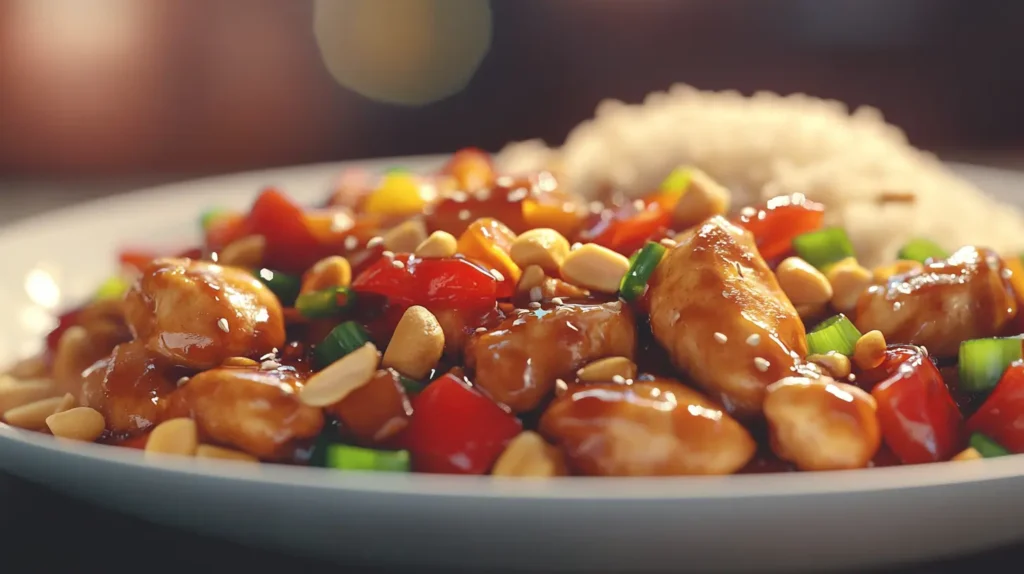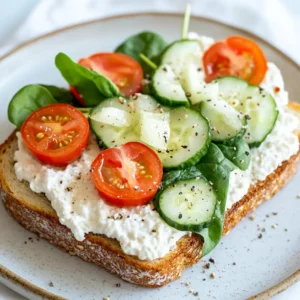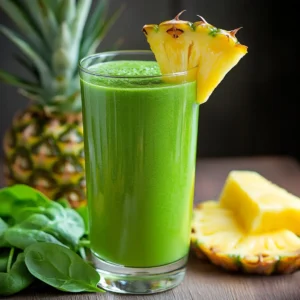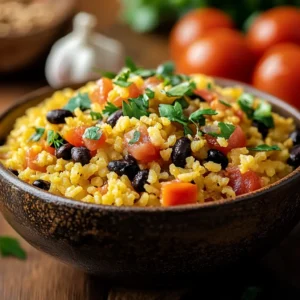Kung Pao Chicken is not just a dish; it’s a culinary masterpiece that has captured the hearts and taste buds of millions around the world. This flavorful stir-fry has its roots deeply embedded in Sichuan cuisine, known for its bold flavors and spicy, numbing sensations. What makes Kung Pao Chicken unique is the perfect harmony between heat, sweetness, and a savory umami flavor, combined with the crunch of roasted peanuts and the heat from dried red chilies. It’s a dish that offers a rich combination of textures and flavors that have made it a favorite in Chinese restaurants worldwide.
But how did Kung Pao Chicken come to be? It all begins in the Sichuan province of China, where it has been served for centuries. Originally, the dish was named after Ding Baozhen, a Qing Dynasty official. Ding was not only a governor in the Sichuan province but also a lover of this particular stir-fried chicken dish. The name “Kung Pao” is a reference to his title as a “palace official.” Over time, the dish became synonymous with rich, spicy flavors and the classic combination of chicken, peanuts, and chili peppers.
Kung Pao Chicken has undergone many transformations since its humble beginnings. What was once a simple, rustic dish has become a global phenomenon. Whether you’re enjoying it in a local Chinese restaurant, making it at home, or even ordering it takeout, Kung Pao Chicken is a dish that holds a special place in the hearts of those who love Chinese food. Its popularity has spread far beyond the borders of China, making it a staple in Chinese-American cuisine and a go-to choice for anyone seeking a flavorful, satisfying meal.
While the dish’s origins may be rooted in traditional Sichuan cooking, Kung Pao Chicken has been adapted in many countries, and each version offers a slightly different twist on the original recipe. In the United States, for example, you’ll often find the dish made with bell peppers and sometimes even cashews in place of peanuts. Despite these variations, the core elements of Kung Pao Chicken — the tender chicken, the spicy heat, and the crispy peanuts — remain unchanged.
What makes this dish so irresistible is its balance of flavors. The heat from the dried chilies and Sichuan peppercorns gives the dish its signature spiciness, while the soy sauce and hoisin sauce provide the rich, savory umami base. The peanuts add a delightful crunch, and the sweetness from the sugar or hoisin sauce adds just the right contrast to the heat. Together, these ingredients create a dish that is bursting with complex, layered flavors.
In this article, we will guide you through everything you need to know to make the perfect Kung Pao Chicken at home. From understanding the history and the key ingredients to learning how to recreate this dish in your own kitchen, you’ll have all the tools you need to create a delicious, authentic Kung Pao Chicken that rivals any restaurant version. Whether you’re an experienced home cook or a beginner looking to try something new, this recipe is easy to follow and will leave you with a dish that’s full of flavor and satisfaction.
We’ll also explore the best ways to customize Kung Pao Chicken based on your preferences, whether you want to add more spice, swap out ingredients, or make a vegetarian version. So grab your wok, gather your ingredients, and get ready to embark on a flavorful journey with Kung Pao Chicken — a dish that is as exciting to make as it is to eat.
What is Kung Pao Chicken?
Origin of Kung Pao Chicken:
Kung Pao Chicken, or Gong Bao Ji Ding, has a rich history that dates back to the Qing Dynasty (1644-1912). The dish is named after Ding Baozhen, a governor of the Sichuan province. He was a fan of this particular stir-fried chicken dish, and as a result, it became known as “Kung Pao” — “Kung” meaning “palace official” and “Pao” meaning “protecting” or “guardian.” Over time, the dish became popular throughout China and eventually found its way to Western menus, especially in American Chinese cuisine.
Kung Pao Chicken was originally a simple dish of diced chicken cooked with peanuts, dried red chilies, and a mixture of soy sauce and other seasonings. The Sichuan version, known for its bold flavors and numbing sensation from Sichuan peppercorns, has evolved into a dish that’s loved worldwide.
The Key Ingredients in Kung Pao Chicken:
To make an authentic Kung Pao Chicken, it’s important to understand its signature ingredients. These include:
- Chicken: Diced boneless, skinless chicken breast or thighs are typically used.
- Peanuts: Roasted, unsalted peanuts add a crunchy texture that contrasts with the tender chicken.
- Dried Red Chilies: These chilies provide the dish with its signature spicy kick.
- Sichuan Peppercorns: These peppercorns create a tingling or numbing sensation that is a hallmark of Sichuan cuisine.
- Soy Sauce and Vinegar: Soy sauce adds a savory umami flavor, while vinegar contributes a tangy contrast to the heat.
These ingredients, when combined in the right proportions, create the irresistible flavors that make Kung Pao Chicken such a memorable dish.

The Essential Kung Pao Chicken Recipe

Ingredients for Kung Pao Chicken:
Before you start cooking, gather all the ingredients to ensure a smooth preparation process. Here’s what you’ll need for an authentic Kung Pao Chicken recipe:
- 1 lb boneless, skinless chicken breasts (or thighs), cut into bite-sized cubes
- 1/2 cup roasted unsalted peanuts
- 8-10 dried red chilies
- 1 tablespoon Sichuan peppercorns
- 2 tablespoons soy sauce (low-sodium preferred)
- 1 tablespoon rice vinegar
- 1 tablespoon hoisin sauce
- 1 teaspoon sugar
- 2 teaspoons cornstarch
- 1 tablespoon vegetable oil
- 2 cloves garlic, minced
- 1-inch piece of ginger, minced
- 1/2 onion, diced
- 1/2 bell pepper, diced
- Salt to taste
Instructions for Kung Pao Chicken:
- Prepare the Chicken:
Toss the chicken cubes in 1 tablespoon soy sauce and 2 teaspoons of cornstarch. Allow it to marinate for at least 10 minutes. This will help tenderize the chicken and give it a slightly crispy texture when cooked. - Make the Sauce:
In a small bowl, combine the soy sauce, rice vinegar, hoisin sauce, sugar, and a pinch of Sichuan peppercorns. Stir until the sugar dissolves, and the sauce is evenly mixed. - Cook the Chicken:
Heat a wok or large skillet over medium-high heat. Add 1 tablespoon of vegetable oil. Once the oil is hot, add the marinated chicken cubes. Stir-fry the chicken until golden brown and crispy on the outside, about 6-8 minutes. Once cooked, remove the chicken from the wok and set it aside. - Stir-Fry the Vegetables and Aromatics:
In the same wok, add a little more oil if necessary. Add the garlic, ginger, onion, and bell pepper. Stir-fry for 2-3 minutes until fragrant and the vegetables are tender-crisp. - Add Peanuts, Chilies, and Sauce:
Add the roasted peanuts, dried chilies, and the Sichuan peppercorns to the wok. Stir everything together for another 2 minutes, allowing the flavors to combine. Then, pour in the prepared sauce, stirring to coat everything evenly. - Return the Chicken to the Wok:
Add the cooked chicken back into the wok, tossing everything together until the chicken is fully coated with the sauce and the peanuts are well-distributed. - Final Touch:
Stir-fry for an additional 2 minutes, allowing the sauce to thicken slightly. Taste and adjust the seasoning if necessary, adding a pinch of salt or extra soy sauce. - Serve:
Serve your Kung Pao Chicken hot with steamed white rice or fried rice.

Tips for Making the Best Kung Pao Chicken
Choosing the Right Chicken:
While both chicken breasts and thighs work for Kung Pao Chicken, thighs tend to provide more flavor and juiciness due to their higher fat content. However, chicken breasts are leaner and provide a lighter alternative. For a crispy texture, consider cutting the chicken into smaller, bite-sized cubes and marinating them in cornstarch to help with the crisping process.
Adjusting the Spice Level:
Kung Pao Chicken is known for its heat, but you can always adjust the spice level to suit your preferences. If you prefer a milder version, reduce the number of dried red chilies, or remove the seeds from the chilies before adding them to the dish. For extra heat, increase the amount of dried chilies or add fresh chili peppers such as jalapeños or Thai bird’s eye chilies.
Peanuts and Crunch:
The peanuts in Kung Pao Chicken are an essential component of the dish, providing a crunchy texture and nutty flavor. Make sure to use roasted, unsalted peanuts for the best results. If you want an extra crunch, lightly toast the peanuts in a dry pan before adding them to the dish.
How to Customize Your Kung Pao Chicken
Vegetarian Kung Pao Chicken:
If you prefer a vegetarian version of Kung Pao, simply substitute the chicken with tofu, tempeh, or even seitan. To prepare tofu, press it to remove excess moisture, then cut it into cubes. Pan-fry the tofu until crispy before adding it to the dish. The tofu will absorb the flavors of the sauce just as well as chicken does, providing a satisfying alternative for vegetarians and vegans.
Other Protein Options:
Kung Pao Chicken can easily be adapted to other proteins. Shrimp, beef, or pork all work well in this dish. When using shrimp, cook them just until pink and tender to avoid overcooking. For beef or pork, slice them thinly against the grain for tenderness.
What to Serve with Kung Pao Chicken
Rice Options:
Kung Pao Chicken is traditionally served with steamed white rice, which acts as a neutral base to balance the spicy, savory flavors of the dish. If you want to get creative, try serving it with jasmine rice, brown rice, or fried rice for added texture and flavor.
Vegetable Sides:
Kung Pao Chicken pairs beautifully with a variety of vegetable sides. Some options include stir-fried greens such as bok choy, Chinese broccoli, or spinach. You can also serve it alongside sautéed green beans or roasted cauliflower for added nutrients and variety.
Common Mistakes to Avoid When Making Kung Pao Chicken
Overcooking the Chicken:
To ensure the chicken remains tender and juicy, avoid overcooking it. The chicken should be golden brown and cooked through but not dry. Be careful not to leave it in the pan for too long once it’s browned, as it can become tough.
Not Enough Spice:
The hallmark of Kung Pao Chicken is its spicy and numbing sensation. If you reduce the spice too much, you’ll miss out on the dish’s signature flavor. Always taste the dish and adjust the chili and Sichuan peppercorns according to your spice tolerance.
Healthier Versions of Kung Pao Chicken
Low-Sodium Soy Sauce:
To make your Kung Pao Chicken a bit healthier, try using low-sodium soy sauce. This can significantly reduce the sodium content of the dish without sacrificing flavor.
Reducing Sugar and Oil:
The sauce in Kung Pao Chicken contains sugar to balance out the heat and acidity. For a healthier version, you can reduce the sugar or substitute it with natural sweeteners like honey or stevia. Additionally, you can use less oil for stir-frying, or opt for healthier oils like olive oil or avocado oil.
Kung Pao Chicken Around the World
American Chinese Kung Pao Chicken:
In the United States, American Chinese restaurants often serve a version of Kung Pao Chicken that includes bell peppers and sometimes even cashews instead of peanuts. While this variation deviates from the traditional recipe, it has become a popular adaptation, especially in fast-casual dining.
Sichuan Kung Pao Chicken:
The authentic Sichuan version of Kung Pao Chicken is typically much spicier and includes more Sichuan peppercorns, which provide a numbing effect on the tongue. The Sichuan style is also known for using larger quantities of dried chilies, which deliver a punch of heat.
Conclusion
Kung Pao Chicken is far more than just a dish; it’s an experience — one that brings together a unique combination of flavors and textures, along with a fascinating history rooted in Sichuan cuisine. From its origins as a dish beloved by a Qing Dynasty official to its widespread popularity in Chinese restaurants and homes around the world, Kung Pao Chicken has proven itself to be a timeless classic. Its signature balance of spice, sweetness, and savory depth makes it a standout in Chinese cooking, and its adaptability ensures that it can cater to a wide range of tastes and preferences.
Whether you prefer it with the traditional roasted peanuts or want to customize the dish with cashews, bell peppers, or tofu, Kung Pao Chicken’s versatility makes it an excellent option for any cook. The dish can be easily adjusted to suit dietary needs, spice levels, and flavor preferences, ensuring that everyone can enjoy this delightful recipe in their own way. From reducing the heat for a milder version to incorporating additional vegetables for a richer texture, Kung Pao Chicken is a great dish to experiment with and make your own.
In addition to its delicious taste, Kung Pao Chicken also embodies a significant part of Chinese culinary tradition. It showcases the balance of contrasting flavors — sweet, salty, spicy, and savory — that are characteristic of many traditional Chinese dishes. By mastering the art of Kung Pao Chicken, you’re not just learning to cook a single dish; you’re delving into the heart of Sichuan cuisine and understanding how these flavor combinations work together to create something truly memorable.
Making Kung Pao Chicken at home offers several benefits beyond just a great meal. It’s a wonderful way to bring the flavors of Chinese cuisine into your kitchen without needing to rely on takeout or pre-packaged sauces. The recipe we’ve provided is simple, straightforward, and accessible for cooks of all experience levels. By using fresh ingredients, you can control the flavors and make the dish as spicy, savory, or sweet as you desire.
As you become more familiar with the ingredients and techniques involved in preparing Kung Pao Chicken, you’ll find that it becomes easier to tweak the recipe to suit your tastes and those of your family and friends. You’ll also gain a deeper appreciation for the layers of flavor that make Chinese cuisine so complex and fascinating. Every bite of Kung Pao Chicken provides a burst of flavor that keeps you coming back for more — the crunchy peanuts, the tender chicken, the heat from the chilies, and the tangy sweetness of the sauce. All these elements work together in perfect harmony, creating a dish that never fails to satisfy.
For those who enjoy exploring different cuisines and discovering new flavors, Kung Pao Chicken is a fantastic dish to add to your repertoire. It offers a balance of textures and tastes that can be enjoyed by everyone, from spice lovers to those who prefer a milder approach. As you share this dish with your loved ones, whether as part of a weeknight dinner or a special celebration, it will undoubtedly become a favorite in your household.
As you continue to explore Chinese cooking, Kung Pao Chicken serves as a great starting point for further culinary adventures. The flavors and techniques learned from making this dish can easily be applied to other recipes within Sichuan and broader Chinese cuisine, allowing you to expand your cooking skills and deepen your appreciation for this rich and diverse culinary tradition.
In conclusion, Kung Pao Chicken is a versatile, flavorful, and enjoyable dish that is perfect for anyone looking to dive into the world of Chinese cuisine. With its rich history, bold flavors, and the ability to be customized to fit any preference, it’s easy to see why Kung Pao Chicken continues to be a popular choice for home cooks and restaurant-goers alike. So whether you’re preparing it for a quick weeknight meal, a gathering with friends, or a special family dinner, this dish is sure to impress with its layers of taste and textures.
So next time you’re looking for a delicious, flavorful meal that combines spicy heat with savory satisfaction, remember Kung Pao Chicken — a dish that’s as rich in history as it is in flavor.
https://www.webpilot.ai/writeDetail/83581249-bd71-44f2-bc10-a373c6bf6514?lang=en-US



